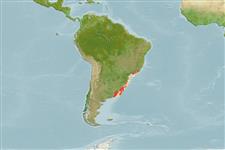>
Clupeiformes (Herrings) >
Alosidae (Shads and Sardines)
Etymology: Brevoortia: From James Carson Brevoort (1818-1887), studie the fauna from Ohio and South Caroline (Ref. 45335).
More on authors: Spix & Agassiz.
Environment: milieu / climate zone / depth range / distribution range
Ecologia
marino. Subtropical; 22°S - 38°S, 60°W - 42°W (Ref. 188)
Southwest Atlantic: Rio de Janeiro, Brazil probably to mouth of Rio de la Plata, Argentina (needs confirmation).
Size / Peso / Age
Maturity: Lm ? range ? - ? cm
Max length : 34.4 cm TL maschio/sesso non determinato; (Ref. 111977)
Spine dorsali (totale): 0; Spine anali 0. Scutes apparent along belly. Upper jaw with distinct median notch. Pectoral fin tip short of pelvic fin base by width of 3 to 7 scales; pelvic fin with oblique and almost straight hind margin. Pre-dorsal scales modified; scales on back and above base of anal fin not markedly smaller than rest. A black spot behind gill opening, but none along flank.
Forms schools (Ref. 188). The morphological characteristics observed and the composition of the trophic spectrum indicate that this species is a filter-feeder, consuming mainly phytoplankton (Ref. 34154).
Life cycle and mating behavior
Maturità | Riproduzione | Deposizione | Uova | Fecundity | Larve
Whitehead, P.J.P., 1985. FAO Species Catalogue. Vol. 7. Clupeoid fishes of the world (suborder Clupeoidei). An annotated and illustrated catalogue of the herrings, sardines, pilchards, sprats, shads, anchovies and wolf-herrings. FAO Fish. Synop. 125(7/1):1-303. Rome: FAO. (Ref. 188)
IUCN Red List Status (Ref. 130435)
Threat to humans
Harmless
Human uses
Pesca: commerciale
Informazioni ulteriori
BibliografiaAcquacolturaProfilo di acquacolturaVarietàGeneticaElectrophoresesEreditarietàMalattieElaborazioneNutrientsMass conversion
CollaboratoriImmaginiStamps, Coins Misc.SuoniCiguateraVelocitàModalità di nuotoArea branchialeOtolithsCervelliVista
Strumenti
Special reports
Download XML
Fonti Internet
Estimates based on models
Preferred temperature (Ref.
123201): 12.6 - 22.8, mean 16.8 °C (based on 104 cells).
Phylogenetic diversity index (Ref.
82804): PD
50 = 0.5156 [Uniqueness, from 0.5 = low to 2.0 = high].
Bayesian length-weight: a=0.00794 (0.00471 - 0.01341), b=3.06 (2.92 - 3.20), in cm total length, based on LWR estimates for this species & Genus-body shape (Ref.
93245).
Trophic level (Ref.
69278): 2.8 ±0.31 se; based on food items.
Resilienza (Ref.
120179): Alto, tempo minimo di raddoppiamento della popolazione meno di 15 mesi (Assuming tm=1).
Fishing Vulnerability (Ref.
59153): Low vulnerability (24 of 100).
Climate Vulnerability (Ref.
125649): Very high vulnerability (79 of 100).
Nutrients (Ref.
124155): Calcium = 112 [63, 192] mg/100g; Iron = 1.62 [0.89, 2.74] mg/100g; Protein = 19.5 [18.3, 20.6] %; Omega3 = 0.536 [0.326, 0.892] g/100g; Selenium = 21 [11, 42] μg/100g; VitaminA = 10.8 [3.5, 29.5] μg/100g; Zinc = 0.996 [0.692, 1.440] mg/100g (wet weight);
